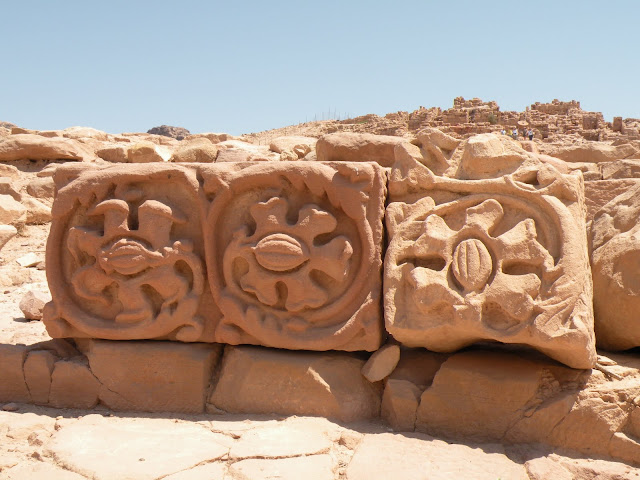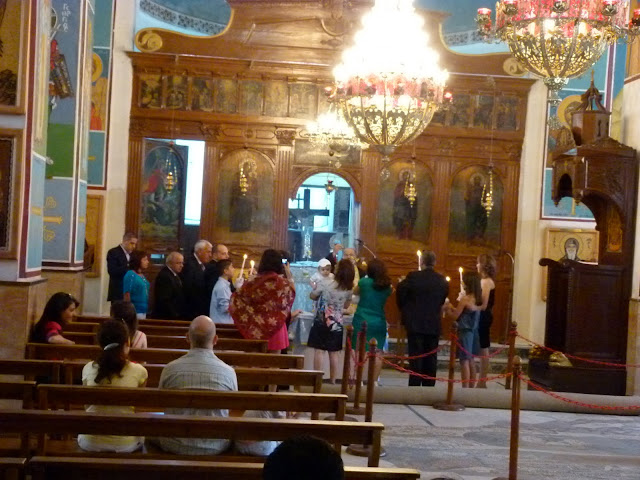As we awaken to the beautiful view of the Petra mountain range the anticipation of our visit to the ancient city builds. This is our final day of our wonderful journey and another highlight of our trip. The Nabetean Arabs built the ancient city of Petra from 800 BC to 100 AD. In this era Petra was a fortress carved out of craggy rocks in an area, which was virtually inaccessible. In the first and second century, after the Romans took over, the city reached the peak of its fame. Petra covers an area of about 100 square kilometers, where over 800 monuments can be found. When shipping slowly displaced caravan routes, the city's importance gradually dwindled; it fell into disuse and was lost to the world until 1812, when it was re-discovered by the Swill explorer Johann Ludwig Burckhardt. Nowadays Petra is Jordan's number one tourist attraction, know as the "rose-red city half as old as time". The Khazneh (the Treasury) starred in the movie Indiana Jones and the Last Crusade (which ironically is on television as I am writing this blog).
We walked for a total of four hours through Petra; three hours with our guide Sameh, then lunch on the site on our own and an hour walk back to the entrance of the city and a horse ride to the site entrance to meet up with our driver. The walk through the canyon was beautiful and very interesting as we learned the were two water systems carved into the rocks, one for drinking water, the other for irrigation. They were originally lined with ceramic pipes to keep the water clean. The city was a place where they buried their dead so the tombs were everywhere. It was a great example of the different status of people of the time as the wealthy had very detailed tombs and the lower class were buried in catacombs. You could see the influence of the Roman society when it was there with temples, columns and churches. The red rocks where somewhat like Sedona, Arizona but with different minerals running through them to create beautiful patterns.
This was a great finish to our great adventure through Egypt and Jordan.......a trip of a lifetime. We had such an educational and experiential trip, filled with memories to last forever. Thanks for sharing in our adventure with us, I hope you enjoyed some of our highlights. It was good to get home, but we are so grateful that we were able to travel to such a historical place on this planet.
Egypt/Jordan Adventure
Join us our adventure!!
Journey with us through Egypt and Jordan
Sunday, July 10, 2011
July 1st-Mount Nebo, Madaba and Kerak
We begin our overnight excursion to Petra along the Kings' Highway. http://www.atlastours.net/jordan/kings_highway.html,
This highway was the original trade route through Jordan and was also very important during biblical times. As it is a modern highway now we were able to see a small portion of the original road when we got closer to Petra. The scenery was beautiful and we enjoyed our three hour road trip very much. The first stop was Mount Nebo, the mountain where Moses was allowed to see the Holy Land and not allowed to enter it. Nowadays the mountain is a memorial site. Here is the "Church of Moses" built by the first Christians. Ever since the first days of Christianity this mountain has been a holy place and destination for pilgrimage. Like Moses, the view is over Jordan, the Dead Sea and Israel. When the weather is clear you can even see Jerusalem which is about 60 kilometers away. We were able to see the mountains of Israel when we were there. The view was magnificent and there was a feeling of peace and serenity on the mountain, truly an amazing place.
 |
| Mosaic Floors from the original church |
 |
| Beduoin Tent |
Madaba the "City of Mosaics" is perched on an archaeological site with more than 4,000 years of history buried beneath it. The quality and quantity of mosaic flooring has made Madaba one of the most prominent cities in the world for mosaics. St. George's Church houses the world famous mosaic floor depicting a large mosaic map of Palestine. Centrally located on this floor is a detailed map of Jerusalem as it was during the sixth century AD.
After leaving Madaba we continued on to Kerak to visit the Crusaders Castle of Kerak. Already capital of the Moab reign, Kerak was chosen by the Crusaders to build their stronghold because it was built over a promontory overlooking 360 degrees the valley, it was mid-way between Jerusalem and Shobak, another Crusader castle. We had lunch at the Kings Castle Restaurant and then proceeded on our self guided tour of the castle. The view was spectacular and exploring the castle was fun with all the passageways and rooms that were used for various activities, food preparation, dining, worship, etc. Now on to Petra so that we can see the sunset over the mountains.
Subscribe to:
Comments (Atom)


































































